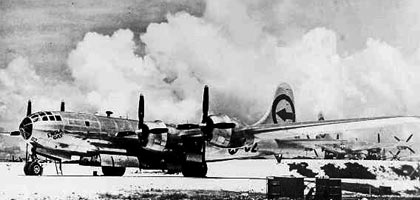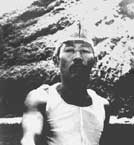

| the expedition | |
| the science | |
| tools & techniques | |
| daily journal | |
| the team | |
| questions & answers | |
|
the islands Saipan Anatahan Sarigan Guguan Alamagan Pagan Agrigan Asuncion Maug Uracas |
|
|||||||||||||||||||||||||||||||||||||||||||||||||||||||||||||||
World War II

The Marianas were one portion of a stealthy network of Japanese military outposts. Under the League of Nations, development of such bases had been forbidden but with an apprehensive United States having no legal authority to physically inspect the islands, the Marianas became part of Japan's perimeter of defense.
On Dec. 10, 1941, in the wake of the Japanese bombing of Pearl Harbor, Hawaii, Japanese troops would take over Guam, which had been purchased by the United States from Spain 43 years earlier. The invasion party was made up in part from military personnel stationed on Saipan.
The Marianas would continue as a Japanese stronghold for two more years. In 1943, the United States saw the need to break Japan's grip on the islands and establish the Marianas as its own launch site for aerial bombardment of the Japanese mainland. The location was needed to accommodate a new American bomber, the B-29, and its 2,800-mile flying range.
The American invasion of Saipan took place on June 15, 1944. It had been preceded by several months of American captures of small, sparsely inhabited islands in the Caroline and Wake chains. Two days before the landing, American ships began a devastating shelling attack on Saipan, the first significantly populated area the Americans had faced during the campaign. Several towns on the island were obliterated.
After 24 days of combat, the United States took over Saipan, 3,100 American troops having been killed and 29,000 Japanese soldiers dying in the fighting. The Americans soon took control of the other islands and immediately began developing them as a military outpost. Barracks to accommodate 50,000 troops were built on Tinian.
Additionally, the airstrip constructed on Tinian would host one of the most famous war sorties ever flown: The Aug. 6, 1945 flight of the Enola Gay, the U.S. Army Air Force bomber that dropped an atomic bomb on Hiroshima, Japan. The aircraft departed Tinian at 2:45 a.m. that day, released the bomb at 8:15 a.m. local time and returned to Tinian at 2:58 p.m, ushering in the Atomic Age during those 12 hours.
On Aug. 9, 1945, another bomber called Bocks Car would take off from Tinian and drop an even larger bomb on the industrial city of Nagasaki. The target was a second choice since the first, the Japanese City of Kokura was obscured by clouds that day.
The two bombings are credited with hastening the end of World War II in the Pacific Theater but they were also the first frightening events of the Atomic Era. The war formally ended on Aug. 15, 1945 though it would not be until Dec. 1 of that year that Japanese holdouts on Saipan, cut off from superiors on the mainland, would formally surrender to the Americans.
 Additionally one of the strangest stories of World War II would take place on the island of Anatahan and not conclude until June 30, 1951. On that
date, a band of Japanese soldiers marooned on the island after their convoy sank in June, 1944 would finally surrender to members of the occupying
U.S. Navy. The surrender came about only after both the American and Japanese governments took part in a campaign to convince the castaways that the
war really had ended.
Additionally one of the strangest stories of World War II would take place on the island of Anatahan and not conclude until June 30, 1951. On that
date, a band of Japanese soldiers marooned on the island after their convoy sank in June, 1944 would finally surrender to members of the occupying
U.S. Navy. The surrender came about only after both the American and Japanese governments took part in a campaign to convince the castaways that the
war really had ended.
last Japanese holdouts
of World War II, June,
1951, Anatahan
